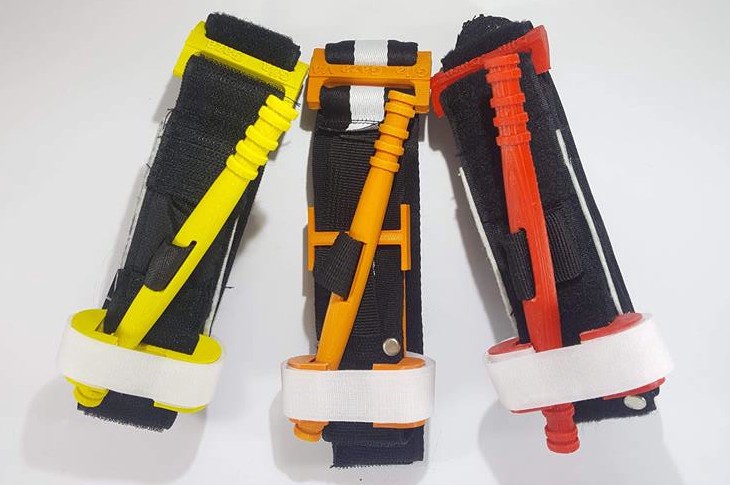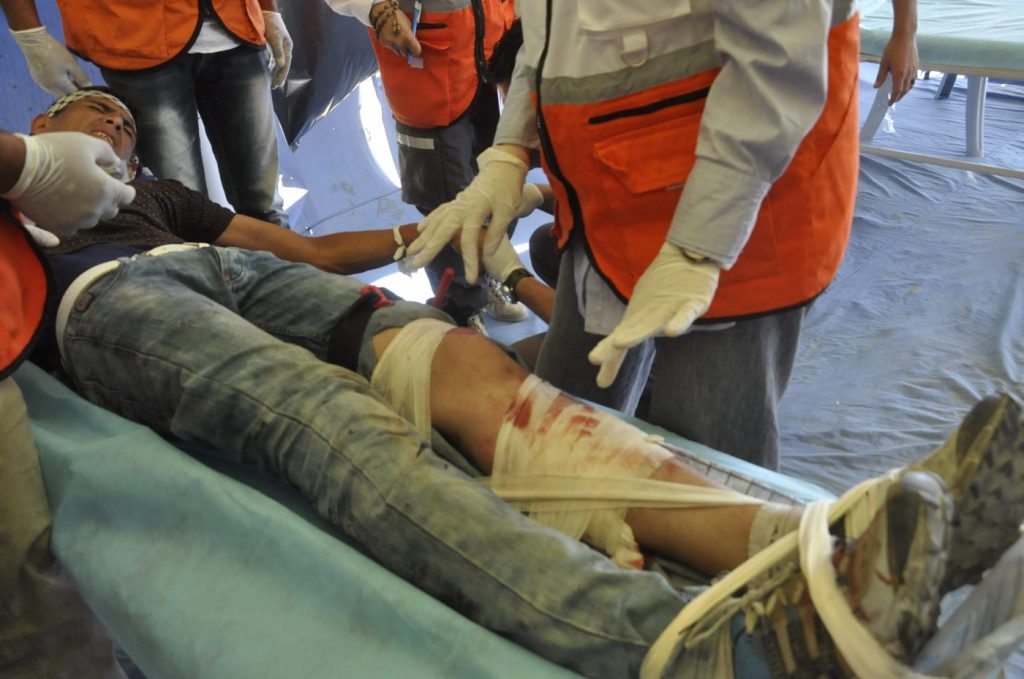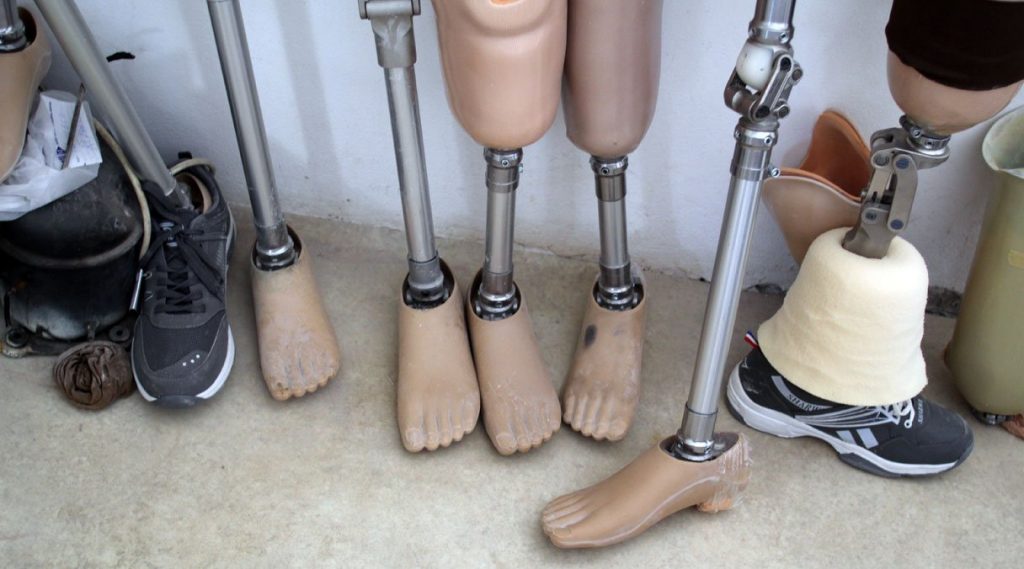Open-source medical device developer Glia has issued an appeal to get its wound-binding tourniquets into Ukraine as the country continues to be bombarded by Russian forces.
Known as the ‘Gaza Tourniquet’ due to its initial usage in Palestine, the low-cost medical device, composed of padding, as well as a buckle, holder, rod and shells, can be 3D printed from ABS and applied to prevent bleeding in the severely injured.
Having received calls from international aid agencies and healthcare workers across Ukraine asking for assistance, Glia has now not only made the bandage’s design files free for medics on the ground to download via Github, but launched a fundraiser through which it’s seeking to raise $25,000 towards manufacturing and shipping them to those in need.
“Glia will create tourniquets in Canada and in Ukraine, as well as disseminate our experience of how to produce more in battlefield conditions,” explains Glia’s fundraising page. “These tourniquets will be distributed to hospitals and civilians in Ukraine who are at risk of serious injury and death.”
“We’re watching a humanitarian tragedy unfold in Ukraine, and civilians are bearing the brunt of it. We can and must help.”

The origins of Glia’s tourniquet
Established with the goal of “creating medical hardware that’s easily accessible and can be manufactured in low-resource settings,” the Glia Project has developed a mini-range of proprietary clinical devices in recent years. These not only include the Gaza Tourniquet, but face shields, an otoscope and a stethoscope as well, which together, are already being used in their thousands around the world.
The latter is particularly impressive, in that Glia says that it performs as well as traditional Littmann Cardiology III stethoscopes, but can be 3D printed at a fraction of the price. Built around the Littmann’s design, now that its patent has expired, the team’s stethoscope costs just $20 to manufacture, and it has even gained a Medical Device Establishment License from the Health Canada authority.
In terms of Glia’s compression bandage, the Gaza Tourniquet was dreamt up in response to protests in Palestine’s Gaza Strip during 2018, which between March 30 and May 4, 2018, were said to have resulted in over 2,800 injuries.
Amid reports of shortages of medical supplies in the region, Glia responded, with Drs. Loubani and Al-Attar, who still work for the organization, creating 350 of the devices and going over to help. Alongside 25 other trained first responders, the crew used 100 of these in field testing, before delivering another 100 to the local Hayat Center and deploying a further 150 to treat Palestinian protesters directly.
Although some of Glia’s initial models were reported to suffer failures, these went on to be pulled from usage, and overall, 78 of the team’s revised devices were eventually used to treat patients without issue. As events in Ukraine continue to escalate, the project’s organizers are now urgently seeking to deploy in the country.

A distributed manufacturing campaign
Following the Gaza Tourniquet’s successful field deployment in Palestine, in addition to calls from aid agencies abroad, the Glia team is seeking to bring it to Ukraine as well. In its current iteration, the device can be produced for just $20, around half the price of a gold standard Combat Application Tourniquet (CAT), and with further scaling, its creators think this can be driven down to as little as $13.33.
To make this possible, Glia is seeking to raise an initial $20,000, so that it can manufacture 1,500 of the compression devices, and has committed to spend any extra funding generated on paying for project costs. Additionally, if Russia decides to end its war on the Ukrainian people, the group has pledged to send the devices to other conflict zones in which injured civilians remain in need of treatment.
After careful review, Glia has also released a repository, containing the torniquet’s bill of materials, printing models and assembly instructions, as well as the organization’s own production know-how to-date. In doing so, the device’s developers say they aim to ensure “barrier-free access to its life saving design,” in a way that enables “anyone with a 3D printer” to manufacture it in Ukraine or abroad.
“For anybody who wishes to start producing tourniquets and has previous medical device production experience, contact us,” wrote Loubani in a recent Medium post. “We will help your shop manufacture tourniquets. The goal is to create distributed manufacturing capacity that can meet Ukrainian demand.”
That being said, Loubani has also encouraged those without medical production experience to leave it to the pros, saying that creating “a lifesaving device that might kill somebody if it fails is probably not the place to start.” But those with the skills wanting to do their bit in Ukraine, can access the Gaza Tourniquet’s design files now, while those without are encouraged to donate to Glia’s fundraiser.

3D printing’s warzone applications
Due to the technology’s growing accessibility and cost efficacy compared to traditional manufacturing methods, 3D printing has been deployed numerous times to get aid rapidly to those who need it. Back in 2018, for instance, British charity Syria Relief suggested that the need for prosthetics created by the ongoing Syrian Civil War, could be met with 3D printing, and called for UK government support.
Open-source software developer VFRAME, meanwhile, has developed a means of creating 3D printed warzone munition replicas, designed to help human rights investigators probe potential violations from afar. Manufactured via an SLA 3D printer, these devices have already been made in the image of the illegal cluster bombs allegedly used in Syria, Yemen and Sudan, as part of a Mnemonic project.
3D printing’s applications within the defense industry are well-known, and the technology has been used to build elements of weapons, as well as the bandaging needed to heal those injured by them. The UK’s Defence Science and Technology Laboratory has even raised the prospect of 3D printing explosives before, as part of Ministry of Defence plans to better utilize advanced technologies.
To stay up to date with the latest 3D printing news, don’t forget to subscribe to the 3D Printing Industry newsletter or follow us on Twitter or liking our page on Facebook.
For a deeper dive into additive manufacturing, you can now subscribe to our Youtube channel, featuring discussion, debriefs, and shots of 3D printing in-action.
Are you looking for a job in the additive manufacturing industry? Visit 3D Printing Jobs for a selection of roles in the industry.
Featured image shows three Glia 3D printed ‘Gaza Tourniquets.’ Image via Tarek Loubani, Glia.


